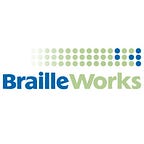Quality Braille Matters
All Braille is not Created Equal
Braille production is an interesting process. For most sighted people, all braille looks the same. It appears to them as random dots on a page, much like an unfamiliar foreign language. However, for the braille reader, those seemingly random dots are printed words. That’s why quality braille matters.
Not only that, your information in alternate formats like braille, large print and audio creates a guest/user experience. That experience can be good or it can be terrible. Alternate format documents are a reflection on your company, so the formatting in braille (or other alternate formats) is just as important as the formatting in your regular marketing materials.
When is created, it’s not a translation but rather a transcription. Braille is simply a different way to “print” (emboss) content. The English alphabet has an English braille equivalent. The Spanish alphabet has a Spanish braille equivalent. Therefore, someone who reads only English braille will not be able to understand Spanish braille. Just like there is a difference in braille from language to language, there is also a difference in how one transcribes and formats braille. In other words, all braille is not created equal.
Formatting Matters
A difference also exists between properly formatted braille and poorly formatted braille.
When an article is authored, care is taken to insert the correct punctuation. Attention to sentence structure is important to eliminate run-on sentences or incomplete sentences. Each detail adds to the reader’s ability to navigate the document and understand the content.
Braille formatting is no different; however, since your company likely doesn’t have a braille reader, you have no way to know if the braille you receive is properly or poorly formatted.
Having a trusted document accessibility partner is critical to delivering your message to every customer.
Proper Formatting vs. Poor Formatting
In our 25+ years of experience, we have seen it all. Unfortunately, many braille companies are simply taking the text in a document and dumping it to the embosser. In many cases, they not only omit punctuation, but they also omit spaces between words. All of the characters are there, but is it readable? Consider the formatting in the two paragraphs below. The content is the same, but which is more readable?
Proper Formatting:
Braille consists of patterns of raised dots arranged in cells of up to six dots in a 3-by-2 configuration. Each cell’s dot arrangement represents a letter, number, or punctuation mark. Also, many commonly used words and letter combinations have their own contracted single-cell pattern. For example, the statement, “You can do it!” uses just one character for each word.
Poor Formatting:
brailleconsistsof patterns of raiseddotsarranged in cells of up to six dots ina3-by-2 configuration.each cell’sdotarrangement representsaletter numberorpunctuation mark.also, many commonlyusedwords andlettercombinations have their own contracted singlecell pattern.for example,the statement,”You can do it!” uses just one character for each word.
Notice above, the difference between the two paragraphs. In the properly formatted paragraph, you see all of the punctuation; capital letters are present at the beginning of each sentence; dashes and quotation marks appear where appropriate.
In the poorly formatted paragraph, all of the letters are there but the content is very difficult to follow because of the missing spaces, capital letters and punctuation.
This is how they look in braille; would you know the difference?
Proper Formatting:
Poor Formatting:
Why Quality Braille is Important
These examples may seem crazy but there are well-known document accessibility companies producing terrible braille.
For example, Braille Works produced documents for a government agency. The next month, the agency engaged another braille company. We received a call from the agency asking what we did to change the braille documents because they were receiving complaints. Apparently, their new company didn’t properly format the braille. We explained to them that we didn’t produce those documents. The agency realized it was the other braille company that produced terrible braille!
Remember, document accessibility is important because it allows you to reach all of your customers and, at the same time, meet the legal requirements for equal access to your information.
Doing your part to follow the law actually helps you reach more customers. Your document accessibility partner should produce a quality braille product that puts your company in the best possible light, while providing a great customer experience for people with a visual disability.
This post was written by Glen Schubert.
Originally published at https://brailleworks.com on February 27, 2020.
